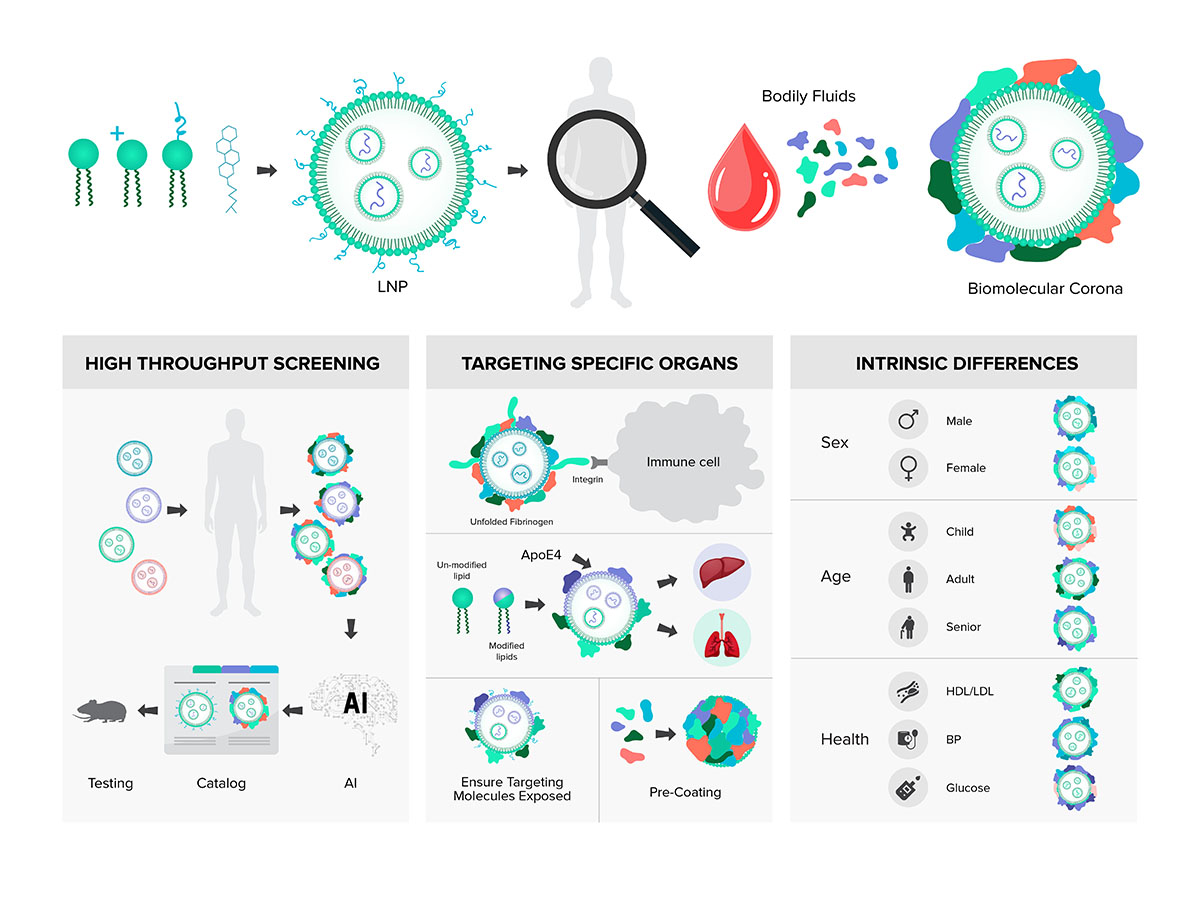| Mar 14, 2024 | |
Harnessing the power of the biomolecular corona to advance lipid nanoparticle therapeutics |
|
| (Nanowerk Spotlight) Lipid nanoparticles (LNPs) have garnered widespread attention following their successful application in delivering mRNA vaccines during the COVID-19 pandemic. However, to fully realize their potential for diverse therapeutic applications, scientists must overcome several clinical hurdles. | |
| In a recent forum published in Trends in Biotechnology ("Precise engineering of the biomolecular corona to accelerate the clinical translation of lipid nanoparticles"), researchers Shahed Behzadi and Morteza Mahmoudi propose that understanding and engineering the biomolecular corona could be the key to surmounting these challenges and accelerating the clinical translation of LNPs. | |
 |
|
| An illustrative scheme demonstrating how insights into the biomolecular corona can effectively tackle the fundamental (pre)clinical challenges associated with lipid nanoparticles. (Imagee: courtesy of the authors) (click on image to enlarge) | |
| The biomolecular corona, a layer of proteins and other biomolecules that forms on the surface of nanoparticles upon interaction with biological fluids, can significantly alter the properties of LNPs and influence their interactions with cells and tissues. By carefully modulating the composition of this corona, researchers may be able to fine-tune the behavior of LNPs and optimize them for specific therapeutic purposes. | |
| One major challenge in LNP development is the need for high-throughput screening to identify the most promising formulations. | |
| "We suggest that analyzing the biomolecular corona profiles of LNPs could provide a more efficient and predictive approach," Mahmoudi tells Nanowerk. "By creating a comprehensive library of corona compositions and integrating it with artificial intelligence, researchers could potentially forecast the biological fate and pharmacokinetics of novel LNP formulations without extensive animal testing." | |
| This innovative strategy could revolutionize the efficiency and predictive power of formulation development, enabling the rapid identification of optimal LNP designs for specific therapeutic applications. | |
| Another key hurdle is achieving targeted delivery of LNPs to specific organs beyond the liver. The authors highlight strategies for engineering the biomolecular corona to enhance organ-specific accumulation, such as modifying the chemical structure of LNP components or pre-coating LNPs with targeting proteins. | |
| One promising approach involves pre-coating LNPs with proteins possessing inherent targeting capabilities. By leveraging the biomolecular corona, these "smart" nanoparticles can home in on desired tissues with enhanced precision. However, challenges such as maintaining ligand functionality in the presence of the biomolecular corona must be addressed to ensure the effectiveness of this targeting strategy. | |
| Importantly, Behzadi and Mahmoudi emphasize the need to consider individual factors such as age, sex (read more: "Sex as an important factor in nanomedicine"), and health status (read more: "The protein corona from nanomedicine to environmental science") when designing LNPs, as these variables can impact the composition of the biomolecular corona and the biological responses to LNPs. This personalized approach holds great promise for developing tailored nanomedicines that cater to the unique needs of different patient populations. However, potential limitations such as nonlinear effects when mixing different ionizable lipid species should be taken into account to ensure the reproducibility and scalability of LNP formulations. | |
| "The biomolecular corona represents a powerful tool for unlocking the full potential of LNPs in clinical applications," Mahmoudi concludes. "By harnessing advanced screening methods, AI, and corona engineering strategies, while accounting for individual variations and addressing current limitations, researchers can develop safer, more effective, and personalized LNP-based therapeutics, revolutionizing the landscape of precision medicine." | |
| As research in this field continues to evolve, the insights provided by Behzadi and Mahmoudi serve as a valuable roadmap for navigating the challenges and opportunities that lie ahead in the clinical translation of LNPs. | |
 By
Michael
Berger
– Michael is author of three books by the Royal Society of Chemistry:
Nano-Society: Pushing the Boundaries of Technology,
Nanotechnology: The Future is Tiny, and
Nanoengineering: The Skills and Tools Making Technology Invisible
Copyright ©
Nanowerk LLC
By
Michael
Berger
– Michael is author of three books by the Royal Society of Chemistry:
Nano-Society: Pushing the Boundaries of Technology,
Nanotechnology: The Future is Tiny, and
Nanoengineering: The Skills and Tools Making Technology Invisible
Copyright ©
Nanowerk LLC
|
|
|
Become a Spotlight guest author! Join our large and growing group of guest contributors. Have you just published a scientific paper or have other exciting developments to share with the nanotechnology community? Here is how to publish on nanowerk.com. |
|
